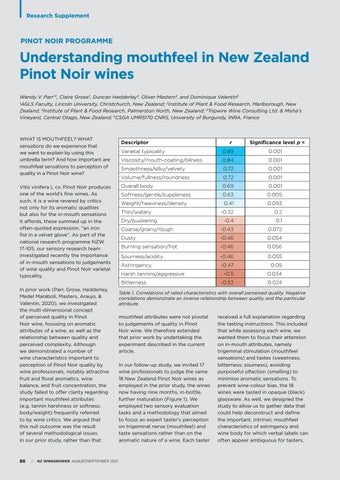Research Supplement
PINOT NOIR PROGRAMME
Understanding mouthfeel in New Zealand Pinot Noir wines Wendy V. Parr*1, Claire Grose2, Duncan Hedderley3, Oliver Masters4, and Dominique Valentin5 1 AGLS Faculty, Lincoln University, Christchurch, New Zealand; 2Institute of Plant & Food Research, Marlborough, New Zealand; 3Institute of Plant & Food Research, Palmerston North, New Zealand; 4Tripwire Wine Consulting Ltd. & Misha’s Vineyard, Central Otago, New Zealand; 5CSGA UMR5170 CNRS, University of Burgundy, INRA, France
WHAT IS MOUTHFEEL? WHAT sensations do we experience that we want to explain by using this umbrella term? And how important are mouthfeel sensations to perception of quality in a Pinot Noir wine? Vitis vinifera L cv. Pinot Noir produces one of the world’s fine wines. As such, it is a wine revered by critics not only for its aromatic qualities but also for the in-mouth sensations it affords, these summed up in the often-quoted expression, “an iron fist in a velvet glove”. As part of the national research programme NZW 17-105, our sensory research team investigated recently the importance of in-mouth sensations to judgements of wine quality and Pinot Noir varietal typicality.
Descriptor
86 //
NZ WINEGROWER AUGUST/SEPTEMBER 2021
Significance level p <
Varietal typicality
0.89
0.001
Viscosity/mouth-coating/oilness
0.84
0.001
Smoothness/silky/velvety
0.72
0.001
Volume/fullness/roundness
0.72
0.001
Overall body
0.69
0.001
Softness/gentle/suppleness
0.63
0.005
Weight/heaviness/density
0.41
0.093
-0.32
0.2
-0.4
0.1
Coarse/grainy/rough
-0.43
0.072
Dusty
-0.46
0.054
Burning sensation/hot
-0.46
0.056
Sourness/acidity
-0.46
0.055
Astringency
-0.47
0.05
-0.5
0.034
-0.53
0.024
Thin/watery Dry/puckering
Harsh tannins/aggressive Bitterness
In prior work (Parr, Grose, Hedderley, Medel Maraboli, Masters, Araujo, & Valentin, 2020), we investigated the multi-dimensional concept of perceived quality in Pinot Noir wine, focusing on aromatic attributes of a wine, as well as the relationship between quality and perceived complexity. Although we demonstrated a number of wine characteristics important to perception of Pinot Noir quality by wine professionals, notably attractive fruit and floral aromatics, wine balance, and fruit concentration, the study failed to offer clarity regarding important mouthfeel attributes (e.g, tannin harshness or softness; body/weight) frequently referred to by wine critics. We argued that this null outcome was the result of several methodological issues in our prior study, rather than that
r
Table 1. Correlations of rated characteristics with overall perceived quality. Negative correlations demonstrate an inverse relationship between quality and the particular attribute.
mouthfeel attributes were not pivotal to judgements of quality in Pinot Noir wine. We therefore extended that prior work by undertaking the experiment described in the current article. In our follow-up study, we invited 17 wine professionals to judge the same 18 New Zealand Pinot Noir wines as employed in the prior study, the wines now having nine months, in-bottle, further maturation (Figure 1). We employed two sensory evaluation tasks and a methodology that aimed to focus an expert taster’s perception on trigeminal nerve (mouthfeel) and taste sensations rather than on the aromatic nature of a wine. Each taster
received a full explanation regarding the tasting instructions. This included that while assessing each wine, we wanted them to focus their attention on in-mouth attributes, namely trigeminal stimulation (mouthfeel sensations) and tastes (sweetness; bitterness; sourness), avoiding purposeful olfaction (smelling) to minimise aromatic sensations. To prevent wine-colour bias, the 18 wines were tasted in opaque (black) glassware. As well, we designed the study to allow us to gather data that could help deconstruct and define the important, intrinsic mouthfeel characteristics of astringency and wine body for which verbal labels can often appear ambiguous for tasters,
